人教版(新)六上 Unit 2 Ways to go to school Part B 第1课时 Let's try ~ Let's talk【优质课件】
文档属性
| 名称 | 人教版(新)六上 Unit 2 Ways to go to school Part B 第1课时 Let's try ~ Let's talk【优质课件】 | 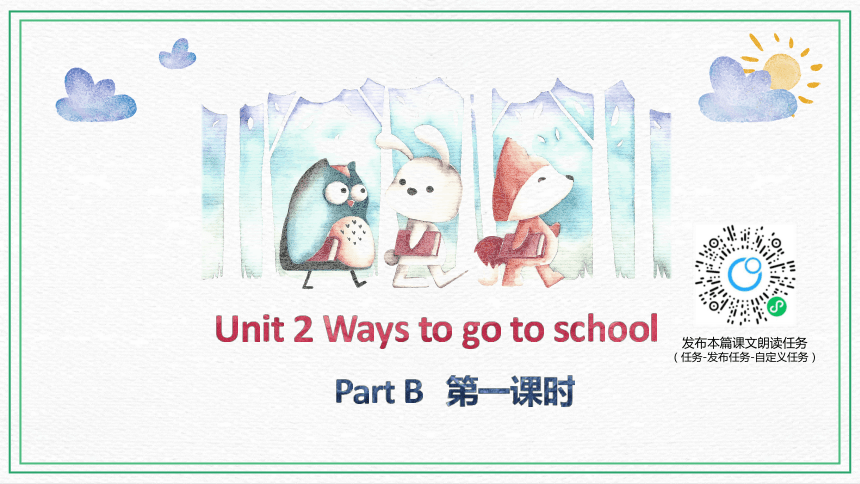 | |
| 格式 | pptx | ||
| 文件大小 | 17.6MB | ||
| 资源类型 | 试卷 | ||
| 版本资源 | 人教版(PEP) | ||
| 科目 | 英语 | ||
| 更新时间 | 2021-12-17 10:41:28 | ||
图片预览


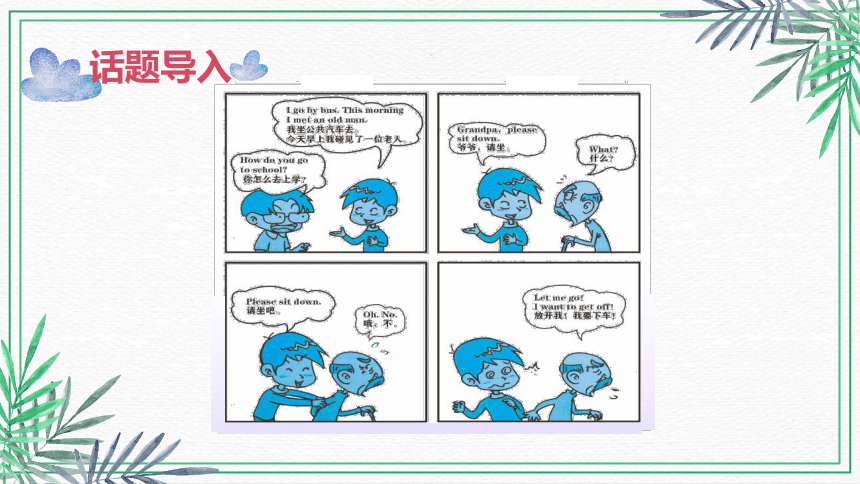
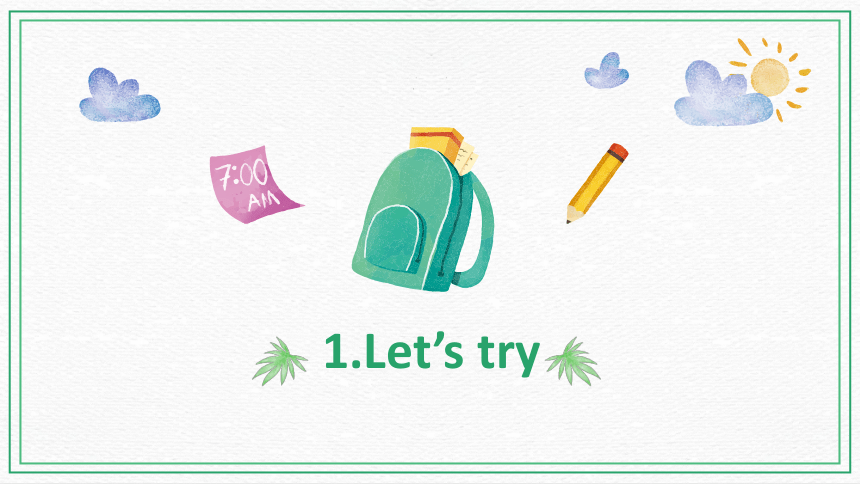
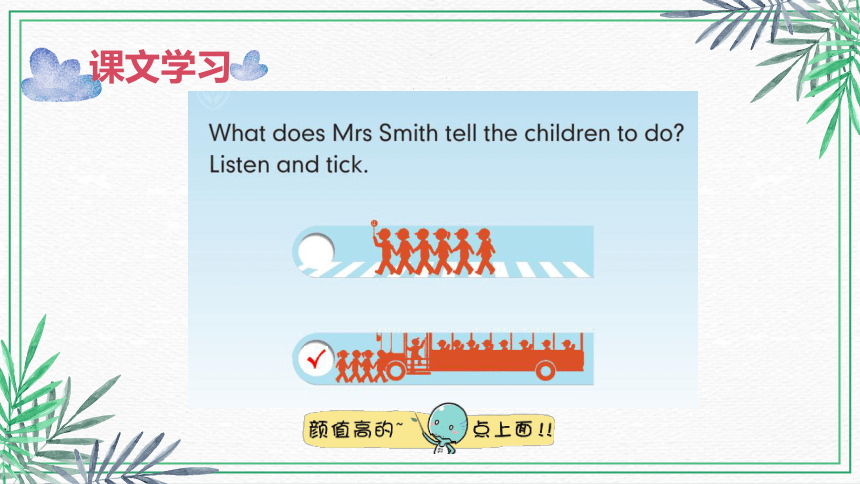
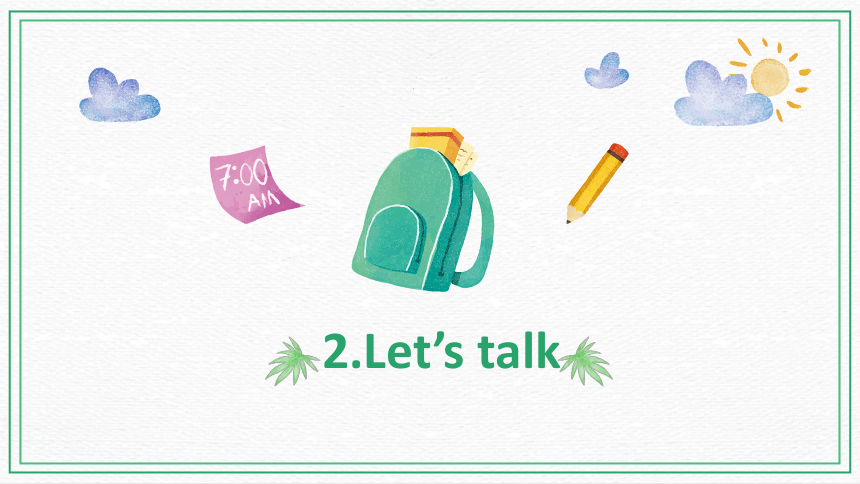
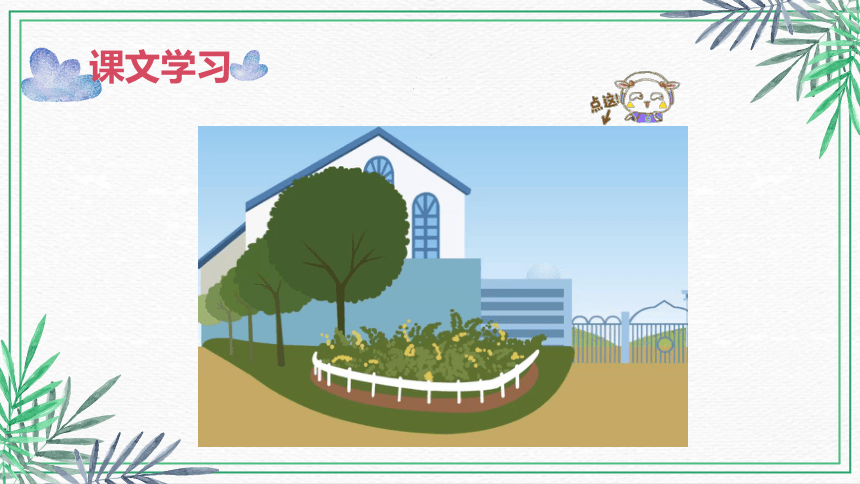

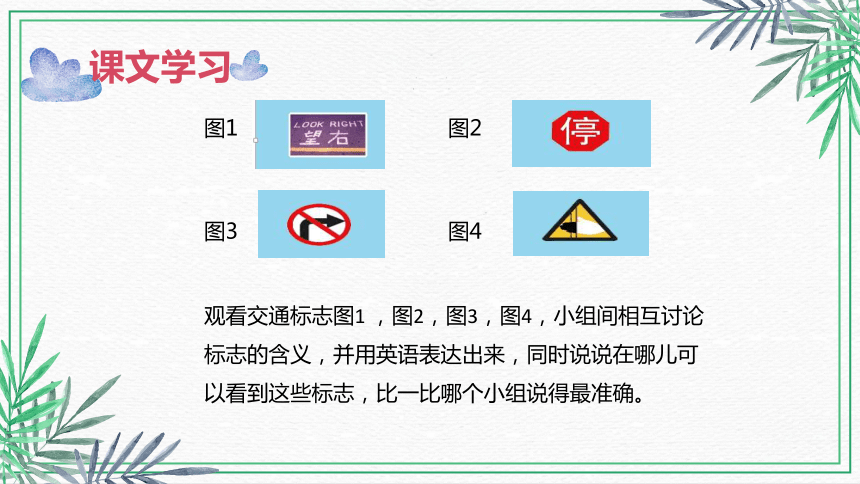
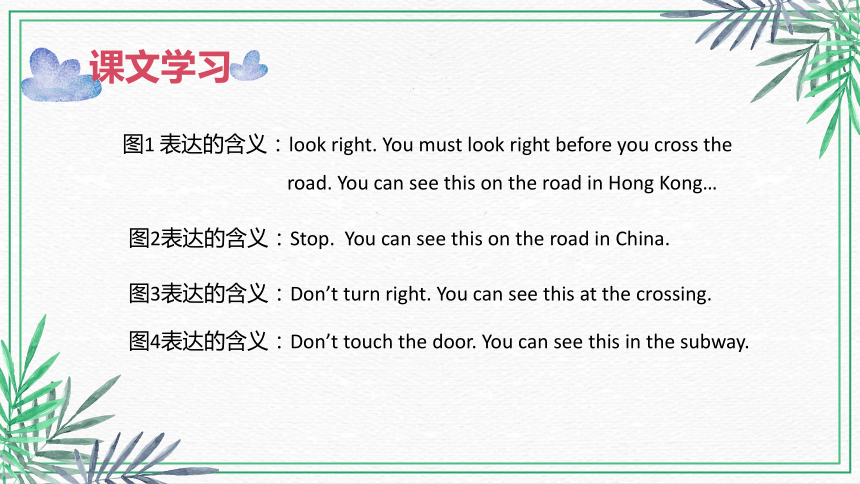
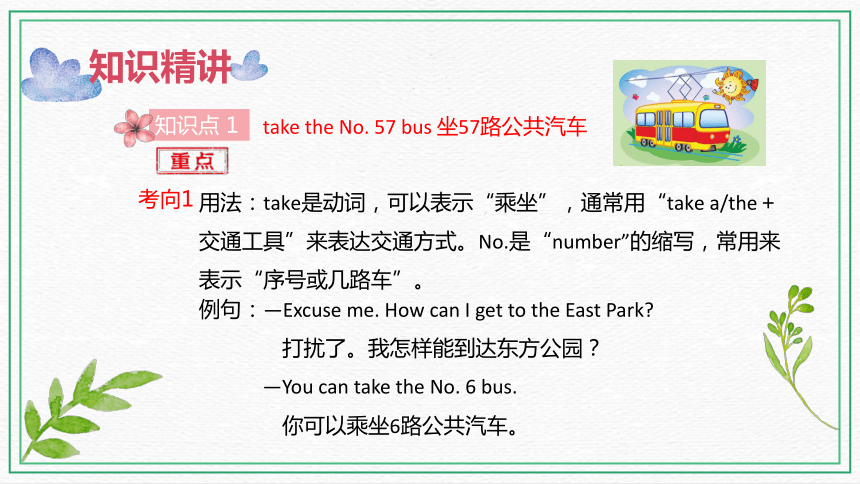
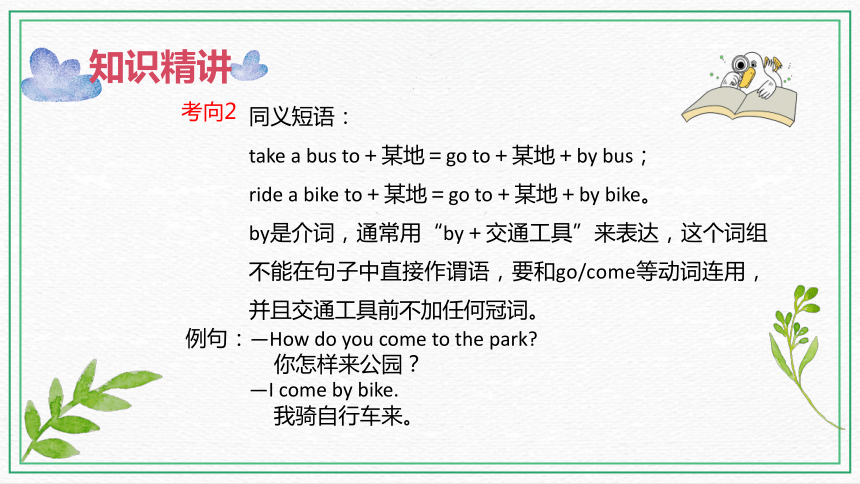
文档简介
(共30张PPT)
Unit 2 Ways to go to school
Part B
第一课时
发布本篇课文朗读任务
(任务-发布任务-自定义任务)
1.Let’s try
2.Let’s talk
3.当堂检测
目录
话题导入
1.Let’s try
课文学习
2.Let’s talk
课文学习
Tell your partner. What do these signs mean Where can you see them
You must look right before you cross the road. You can see this on the road in Hong Kong.
Don’t touch the door. You can see this in the subway.
课文学习
观看交通标志图1 ,图2,图3,图4,小组间相互讨论标志的含义,并用英语表达出来,同时说说在哪儿可以看到这些标志,比一比哪个小组说得最准确。
图1 图2
图3 图4
课文学习
图1 表达的含义:look right. You must look right before you cross the road. You can see this on the road in Hong Kong…
图2表达的含义:Stop. You can see this on the road in China.
图3表达的含义:Don’t turn right. You can see this at the crossing.
图4表达的含义:Don’t touch the door. You can see this in the subway.
课文学习
知识点 1
take the No. 57 bus 坐57路公共汽车
考向1
用法:take是动词,可以表示“乘坐”,通常用“take a/the+ 交通工具”来表达交通方式。No.是“number”的缩写,常用来表示“序号或几路车”。
例句:—Excuse me. How can I get to the East Park
打扰了。我怎样能到达东方公园?
—You can take the No. 6 bus.
你可以乘坐6路公共汽车。
知识精讲
同义短语:
take a bus to+某地=go to+某地+by bus;
ride a bike to+某地=go to+某地+by bike。
by是介词,通常用“by+交通工具”来表达,这个词组不能在句子中直接作谓语,要和go/come等动词连用,并且交通工具前不加任何冠词。
考向2
例句:—How do you come to the park
你怎样来公园?
—I come by bike.
我骑自行车来。
知识精讲
Do you often ________ bus to work
A. by B. take C. take a
C
典型例题
知识点 2
考向
must /m st/
常用句式为:主语+must+动词原形+其他。
In the USA people on bikes must wear one. 在美国骑自行车的人必须戴(头盔)。
例句:I must study hard.
我必须努力学习。
知识精讲
意为“必须”情态动词,后跟动词原形,表示命令、要求,侧重于主观看法,强调有必要或有义务去做某事。
wear /we (r)/v.穿;戴
例句:I often wear my glasses. 我经常戴着我的眼镜。
where 哪里
辨析记忆法:
wear和put on都表示穿或戴,但是put on
表示动作,而wear表示“穿着”这一状态。
同音异义词记忆法:
知识精讲
The little girl always ______a red hat.
A. wear B. wears C. puts on
B
知识精讲
知识点 3
快快长大:在美国骑自行车必须戴头盔
在美国的《自行车法》中明确规定:骑自行车必须戴头盔,而且头盔外面应该有硬塑料罩,因为这样即使摔倒了,头盔在地面上的摩擦力小,骑车人如果头先着地可以随着惯性滑行,减少冲击力。
知识精讲
知识点 4
Don’t go at the red light!
别闯红灯!
考向1
Don’t 引导的否定祈使句:
其结构为“Don’t +动词原形+...”,意为“不要做某事”,用于命令、请求、劝告或警告对方不要做某事。
例句:Don’t open the door, please.
请不要打开门。
知识精讲
考向2
祈使句的其他类型:
1. 动词原形+其他.
例句:Open the door. 打开门。
2. Let+人+动词原形+其他.
例句:Let’s go home now. 让我们现在回家吧。
3. No+名词或动词的-ing 形式!
例句:No swimming!禁止游泳!
知识精讲
Let’s ________(clean) the windows.
clean
典型例题
3.当堂检测
当堂检测
一、图文配对。
A. B. C. D.
( ) 1. Don’t go at the red light!
( ) 2. Don’t touch the door.
( ) 3. You must look right before you cross the road.
( ) 4. Don’t turn right.
C
D
A
B
当堂检测
二、选择正确的单词或短语填空。
pictures, cousin, pay attention to, the USA, coming
1. Look, the bus is __________.
2. So many __________of cats!
3. In _____________ people usually eat food with knives and forks(叉子) .
coming
pictures
the USA
当堂检测
4. We must ___________________the traffic lights.
5. My ________ and I are in the same school. We go to school by bus.
pay attention to
cousin
pictures, cousin, pay attention to, the USA, coming
点拨:
当堂检测
三、单项选择。
( ) 1. You can ________the No. 2 bus to the museum.
A. go B. take C. come
( ) 2. The stamps are ________ my cousin ________ the USA.
A. to, for B. from, in C. for, to
B
B
乘坐公交车用动词take。
( ) 3. People ________bikes must wear helmets in the USA.
A. on B. at C. by
( ) 4. In class, we must pay attention ________ our teacher.
A. at B. for C. to
A
C
pay attention to...注意……
点拨:
当堂检测
四、判断下列对话与图片是否相符,相符的打“√”,不相符的打“×”。
( ) 1. —What’s this
—A helmet.
( ) 2. —Don’t go at the red light!
—You’re right.
( ) 3. —How can I get to the park
—By taxi.
√
×
√
当堂检测
五、将下列句子排成一段合理的对话。
( ) Hey. Don’t go at the red light.
( ) How do we go to the park
( ) Sorry. I must pay attention to the traffic lights.
( ) We can take the No. 1 bus over there.
( ) Come on! The bus is coming. Let’s go!
5
4
1
3
2
当堂检测
本节课我们学习了以下知识,请同学们一定加强巩固,以便能和同学们进行灵活交流哦!
重点词汇:wear
重点短语:take the No. 57 bus
重点句型:In the USA people on bikes must wear one.
Don’t go at the red light!
课堂小结
Thanks for watching.
Unit 2 Ways to go to school
Part B
第一课时
发布本篇课文朗读任务
(任务-发布任务-自定义任务)
1.Let’s try
2.Let’s talk
3.当堂检测
目录
话题导入
1.Let’s try
课文学习
2.Let’s talk
课文学习
Tell your partner. What do these signs mean Where can you see them
You must look right before you cross the road. You can see this on the road in Hong Kong.
Don’t touch the door. You can see this in the subway.
课文学习
观看交通标志图1 ,图2,图3,图4,小组间相互讨论标志的含义,并用英语表达出来,同时说说在哪儿可以看到这些标志,比一比哪个小组说得最准确。
图1 图2
图3 图4
课文学习
图1 表达的含义:look right. You must look right before you cross the road. You can see this on the road in Hong Kong…
图2表达的含义:Stop. You can see this on the road in China.
图3表达的含义:Don’t turn right. You can see this at the crossing.
图4表达的含义:Don’t touch the door. You can see this in the subway.
课文学习
知识点 1
take the No. 57 bus 坐57路公共汽车
考向1
用法:take是动词,可以表示“乘坐”,通常用“take a/the+ 交通工具”来表达交通方式。No.是“number”的缩写,常用来表示“序号或几路车”。
例句:—Excuse me. How can I get to the East Park
打扰了。我怎样能到达东方公园?
—You can take the No. 6 bus.
你可以乘坐6路公共汽车。
知识精讲
同义短语:
take a bus to+某地=go to+某地+by bus;
ride a bike to+某地=go to+某地+by bike。
by是介词,通常用“by+交通工具”来表达,这个词组不能在句子中直接作谓语,要和go/come等动词连用,并且交通工具前不加任何冠词。
考向2
例句:—How do you come to the park
你怎样来公园?
—I come by bike.
我骑自行车来。
知识精讲
Do you often ________ bus to work
A. by B. take C. take a
C
典型例题
知识点 2
考向
must /m st/
常用句式为:主语+must+动词原形+其他。
In the USA people on bikes must wear one. 在美国骑自行车的人必须戴(头盔)。
例句:I must study hard.
我必须努力学习。
知识精讲
意为“必须”情态动词,后跟动词原形,表示命令、要求,侧重于主观看法,强调有必要或有义务去做某事。
wear /we (r)/v.穿;戴
例句:I often wear my glasses. 我经常戴着我的眼镜。
where 哪里
辨析记忆法:
wear和put on都表示穿或戴,但是put on
表示动作,而wear表示“穿着”这一状态。
同音异义词记忆法:
知识精讲
The little girl always ______a red hat.
A. wear B. wears C. puts on
B
知识精讲
知识点 3
快快长大:在美国骑自行车必须戴头盔
在美国的《自行车法》中明确规定:骑自行车必须戴头盔,而且头盔外面应该有硬塑料罩,因为这样即使摔倒了,头盔在地面上的摩擦力小,骑车人如果头先着地可以随着惯性滑行,减少冲击力。
知识精讲
知识点 4
Don’t go at the red light!
别闯红灯!
考向1
Don’t 引导的否定祈使句:
其结构为“Don’t +动词原形+...”,意为“不要做某事”,用于命令、请求、劝告或警告对方不要做某事。
例句:Don’t open the door, please.
请不要打开门。
知识精讲
考向2
祈使句的其他类型:
1. 动词原形+其他.
例句:Open the door. 打开门。
2. Let+人+动词原形+其他.
例句:Let’s go home now. 让我们现在回家吧。
3. No+名词或动词的-ing 形式!
例句:No swimming!禁止游泳!
知识精讲
Let’s ________(clean) the windows.
clean
典型例题
3.当堂检测
当堂检测
一、图文配对。
A. B. C. D.
( ) 1. Don’t go at the red light!
( ) 2. Don’t touch the door.
( ) 3. You must look right before you cross the road.
( ) 4. Don’t turn right.
C
D
A
B
当堂检测
二、选择正确的单词或短语填空。
pictures, cousin, pay attention to, the USA, coming
1. Look, the bus is __________.
2. So many __________of cats!
3. In _____________ people usually eat food with knives and forks(叉子) .
coming
pictures
the USA
当堂检测
4. We must ___________________the traffic lights.
5. My ________ and I are in the same school. We go to school by bus.
pay attention to
cousin
pictures, cousin, pay attention to, the USA, coming
点拨:
当堂检测
三、单项选择。
( ) 1. You can ________the No. 2 bus to the museum.
A. go B. take C. come
( ) 2. The stamps are ________ my cousin ________ the USA.
A. to, for B. from, in C. for, to
B
B
乘坐公交车用动词take。
( ) 3. People ________bikes must wear helmets in the USA.
A. on B. at C. by
( ) 4. In class, we must pay attention ________ our teacher.
A. at B. for C. to
A
C
pay attention to...注意……
点拨:
当堂检测
四、判断下列对话与图片是否相符,相符的打“√”,不相符的打“×”。
( ) 1. —What’s this
—A helmet.
( ) 2. —Don’t go at the red light!
—You’re right.
( ) 3. —How can I get to the park
—By taxi.
√
×
√
当堂检测
五、将下列句子排成一段合理的对话。
( ) Hey. Don’t go at the red light.
( ) How do we go to the park
( ) Sorry. I must pay attention to the traffic lights.
( ) We can take the No. 1 bus over there.
( ) Come on! The bus is coming. Let’s go!
5
4
1
3
2
当堂检测
本节课我们学习了以下知识,请同学们一定加强巩固,以便能和同学们进行灵活交流哦!
重点词汇:wear
重点短语:take the No. 57 bus
重点句型:In the USA people on bikes must wear one.
Don’t go at the red light!
课堂小结
Thanks for watching.
同课章节目录
